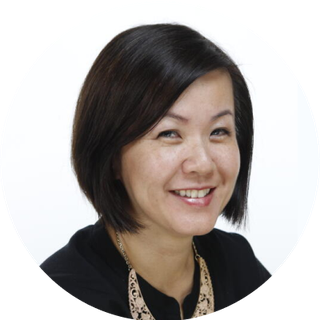Keisuke Takeda
Chef/CEO of Keisuke Singapore

KEISUKE Takeda could well be the Japanese, modern-day version of King Midas. Everything he touches - mostly bowls of ramen and tendon, that is - all turn to gold. There are constant queues every day at all his 12 restaurants in Singapore which include Ramen Keisuke Tonkotsu King, Ginza Tendon Itsuki, and the newest of the lot - Teppanyaki Hamburg Nihonbashi Keisuke Bettei.
The mouthful of a restaurant name serves one of Japan's most well-loved national dishes, the hamburg (say han-ba-ga)steak.
A set meal comes with a prime US beef patty served on a sizzling hot plate with free flow of eggs cooked eight ways, and salad, rice and miso soup, priced from $18.80. This kind of pricing policy is followed by all of his restaurants, so it is not difficult to understand their popularity.
The Hiroshima-born chef started his career in a French restaurant, before venturing into Japanese cuisine. In 2005, he turned to ramen, which was gaining popularity in Japan.
In 2011, he won the title of Ramen King at the Tokyo Ramen Championships, an annual gathering of over 30,000 ramen chefs in Tokyo vying for the coveted title. Today, he has 23 ramen restaurants in Japan.
There are always long queues outside your restaurants, even the older ones that have been opened more than a year ago. What's the secret behind your success?
I believe I offer authentic Japanese food that is created by me. I also keep in mind that I need to cater my food to the local palate. Other Japanese chefs may insist on serving Japanese food their way, but I think about what my customers like.
My restaurants all look successful since Day 1, but that wasn't always the case. When I first opened Ramen Dining Keisuke Tokyo in 2010, in Millenia Walk, there was no business in the first year, because I didn't understand what Singaporeans liked.
Today, what I serve is authentically Japanese, but with a little twist to suit local tastes. For example, Singaporeans love a rich soup. I give diners the option of choosing how rich, salty and oily they like their soup to be, something which is not done in ramen shops in Japan.
And for my tendon, I offer chicken tempura, which is totally unheard of in Japan. But I offer it because Singaporeans love to eat chicken. The Japanese expatriates here may find my food not that authentic, but I'm serving the Singaporean crowd.
Ramen is very popular in Singapore. But what makes yours different from others?
I think that my background in French cuisine makes the difference. While most ramen chefs only know one method of cooking, I can offer more. For example, at Ramen Keisuke Lobster King, the ramen is served in lobster broth, which is similar to a lobster bisque. My days working at French restaurant Le Vincennes, in Shibuya, allowed me to learn how to make bisque and to adapt it to making a ramen broth.
Unlike kaiseiki, where you have several courses to win over a diner, for ramen, you have to capture the diner's heart in one spoonful of broth. Knowing and being able to create different tastes in one bowl of ramen makes the difference.
A good bowl of ramen is one where you can taste the personality and the heart of the chef. I don't think I have achieved that yet, so I'm constantly coming up with new tastes.
Why did you choose Singapore to expand overseas?
Singapore is a place where you get a mix of both Asian and Western cuisines. For a chef like myself, it is a good place to see if my food would be accepted here. It was a challenge in the beginning, but I think I'm doing well now.
You think opening in Tokyo is expensive? The rents in Singapore are so much higher. But the taxes in Singapore are lower, so I'm more profitable.
Besides the ramen restaurants, you have a gyoza restaurant, a tendon restaurant, a sake bar and now one that sells hamburg steaks. Why hamburg steaks?
I like to think of myself as an evangelist of Japanese comfort food. Hamburgs are the most popular comfort food in Japan, so it is not so strange for me to open this restaurant. Besides, there are no hamburg-only restaurants in Singapore, so I'll be the first to open one.
What is your favourite comfort food?
Ramen, naturally. My favourite place is Menya Saimi in Sapporo. I always have a bowl of their miso ramen.
Do you plan to open more restaurants?
I can't reveal too much now, but I will open another two more restaurants this year. The food items may be what Singaporeans are already familiar with, but they will be given the Keisuke twist.
Your ponytail may be the envy of some women. Why do you keep long hair?
I started keeping long hair when I opened my first ramen restaurant. The pony tail and my goatee are a way of creating a character for myself. I see myself as an artist, and food as a form of art.
It is good that people recognise me as the ramen chef with the pony tail. The downside is, I've become too recognisable, so I always have to be on my best behaviour.
BT is now on Telegram!
For daily updates on weekdays and specially selected content for the weekend. Subscribe to t.me/BizTimes
Lifestyle
Former Zouk morphs into mod-Asian Jiak Kim House, serving laksa pasta and mushroom bak kut teh
Massimo Bottura lends star power to pizza and pasta at Torno Subito
Victor Liong pairs Aussie and Asian food with mixed results at Artyzen’s Quenino restaurant
If Jay Chou likes Ju Xing’s zi char, you might too
Mod-Sin cooking izakaya style at Focal
What the fish? Diving for flavour at Fysh – Aussie chef Josh Niland’s Singapore debut
